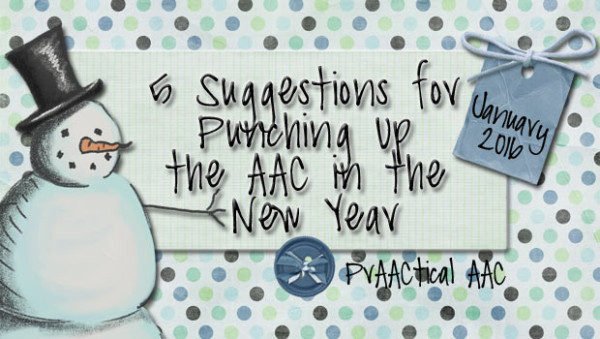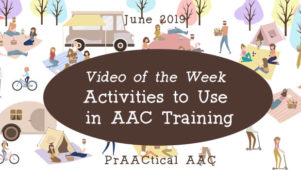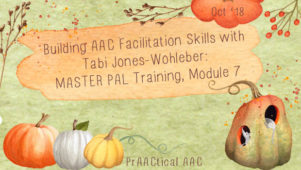5 Suggestions for Punching Up the AAC in the New Year

Novice or expert
Parent or professional
Generalist or specialist
No matter what our differences, we share a common goal of helping AAC learners move forward on the path to better language and literacy. We can all do a little more to help people with AAC needs achieve their potential. Here are some things ideas to get us moving.
- Find a new use for a retired, abandoned, or under-utilized tool. Lots of us are cleaning out closets and drawers at this time of year, and we’re bound to find something that has AAC potential. It could be an old magnetic card reader (great for phonological awareness and other literacy activities), a talking switch (adds flavor to ‘word of the day activities;’ great for telling jokes, getting attention and more), or even some random picture cards (add some spice to the sensory table or hide them around to read the room). Someone’s trash is another person’s treasure.
- Teach someone something you know. Take a few minutes out of your day to share something you’ve learned. How to import an image into an SGD, ways to edit a photo with a free app, how to save Tarheel Reader books to a computer, a great AT Pinterest board to follow, using the search or history function in an AAC device…You know something that someone else does not. Your efforts may give them just the boost they need to advance their own AAC practices.
- Become an active participant in the online AAC community. The presence of web-based supports for has had incredible impact on AAC implementation. If you aren’t already partaking of the wonderful online groups, list servs, blogs, and resources on social media sites, you are missing out on a powerful set of tools. Venues like Facebook, Twitter, Instagram, and Pinterest are not only great sites for learning, but they also provide an opportunity for busy professionals and families to help out other people. You can’t beat the convenience of being able to assist someone with a problem, answer a question, or share a tip at a time and place of your choosing. If you’ve been helped by others in your own AAC journey, this is a great way to pay it forward.
- Join an AAC organization (or renew your membership). There are wonderful supports to be had in the organizations that promote AAC interests, and they need membership to keep going. Tops on my list: USSAAC, ISAAC, and ASHA’s AAC Special Interest Group. Dissatisfied with an organization’s AAC activities? Consider what you can do to create impact. ‘Change from within’ can result in the most powerful and sustainable changes. Can’t manage it financially? Maybe you can support them them in their AAC mission in other ways (see #3).
- Pick an area within the scope of your AAC work and engage in self-reflection. Reflective practices are a terrific way to gain insight into our experiences, and leverage them to become better practitioners. You learn more about the applications of reflective practices to the field of SLP here and here.
Do you have plans for becoming a stronger AAC interventionist in 2016? We’d love to hear about them.
Filed under: PrAACtical Thinking
Tagged With: implementation, professional development, reflective practices
This post was written by Carole Zangari




